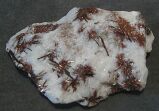
|
| Astrophyllites |
Astrophyllite grows bladed crystals in star-shaped groups, ranging in color from golden to bronze yellow with a metallic luster. It is a rare titanium mineral found in some unusual granites and syenites. Its variable luster can be nearly metallic in one specimen or vitreous in another. Its name translated means star sheets.
Astrophyllite facilitates astral travel. It also enables the user to accept life changes by opening their eyes to new opportunities.
Astrophyllite, which is classified as a inosilicate in the astrophyllite group, is composed of Potassium Sodium Iron Manganese Titanium Silicate Hydroxide. It is a rare and complex mineral that is only found in a few locations, including the Kola Peninsula in Russia, Colorado in the United States, and near Quebec in Canada. It has perfect cleavage in one direction, a vitreous, metallic, sub-metallic, or pearly luster, and can vary from yellow to yellow brown, golden or greenish brown. It has no commercial use other than a mineral specimen, and is often associated with quartz, various feldspars, nepheline, and mica.